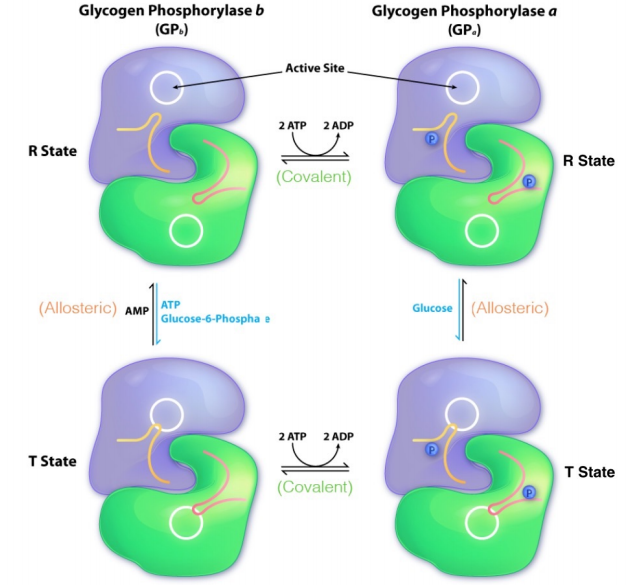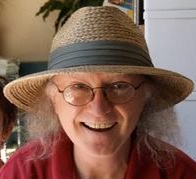8.8: Carbohydrate Storage and Breakdown
- Page ID
- 279717
Carbohydrates are important cellular energy sources. They provide energy quickly through glycolysis and passing of intermediates to pathways, such as the citric acid cycle, and amino acid metabolism (indirectly). It is important, therefore, to understand how these important molecules are used and stored.
Plants are notable in storing glucose for energy in the form of amylose and amylopectin (see and for structural integrity in the form of cellulose. These structures differ in that cellulose contains glucoses solely joined by beta-1,4 bonds, whereas amylose has only alpha1,4 bonds and amylopectin has alpha 1,4 and alpha 1,6 bonds. Animals store glucose primary in liver and muscle in the form of a compound related to amylopectin known as glycogen. The structural differences between glycogen and amylopectin are solely due to the frequency of the alpha 1,6 branches of glucoses. In glycogen they occur about every 10 residues instead of every 30-50, as in amylopectin.
Glycogen Synthesis or Glycogenesis
When the glucose intake is higher than the energy demand, the body stores the glucose excess as glycogen. This process is called glycogenesis. Let us first consider the steps in glycogen synthesis. 1) Glycogen synthesis from glucose involves phosphorylation to form Glucose-6-Phospahte (G6P), and isomerization to form Glucose-1-Phosphate (G1P) (using phosphoglucomutase common to glycogen breakdown). G1P is reacted with UTP to form UDP-glucose in a reaction catalyzed by UDP-glucose pyrophosphorylase. Glycogen synthase catalyzes synthesis of glycogen by joining carbon #1 of the UDPG-derived glucose onto the carbon #4 of the non-reducing end of a glycogen chain. to form the familiar alpha(1,4) glycogen links. Another product of the reaction is UDP.
It is also worth noting in passing that glycogen synthase will only add glucose units from UDPG onto a preexisting glycogen chain that has at least four glucose residues. Linkage of the first few glucose units to form the minimal "primer" needed for glycogen synthase recognition is catalyzed by a protein called glycogenin, which attaches to the first glucose and catalyzes linkage of the first eight glucoses by alpha(1,4) bonds. 3) The characteristic alpha(1,6) branches of glycogen are the products of an enzyme known as Branching Enzyme. Branching Enzyme breaks alpha(1,4) chains and carries the broken chain to the carbon #6 and forms an alpha(1,6) linkage.
The steps in Glycogenesys. Image by Mark Cidade, CC BY-SA 4.0, via Wikimedia Commons
Glycogen Breakdown or Glycogenolysis
When the cell requires energy and there is no glucose available, the body will use its glycogen repository. This process is called Glycogenolysis. Glycogenolysis occurs mostly in the liver and muscle cells. Glycogen phosphorylase (sometimes simply called phosphorylase) catalyzes breakdown of glycogen into Glucose-1-Phosphate (G1P). The reaction, (see below right) that produces G1P from glycogen is a phosphorolysis, not a hydrolysis reaction. The distinction is that hydrolysis reactions use water to cleave bigger molecules into smaller ones, but phosphorolysis reactions use phosphate instead for the same purpose. Note that the phosphate is just that - it does NOT come from ATP. Since ATP is not used to put phosphate on G1P, the reaction saves the cell energy.

Glycogen phosphorylase will only act on non-reducing ends of a glycogen chain that are at least 5 glucoses away from a branch point. A second enzyme, Glycogen Debranching Enzyme (GDE), is therefore needed to convert alpha(1-6) branches to alpha(1-4) branches. GDE acts on glycogen branches that have reached their limit of hydrolysis with glycogen phosphorylase.
If glycogenolysis is taking place in the liver, glucose 6-phosphate can be converted to glucose by the enzyme glucose 6-phosphatase; the glucose produced in the liver is then released to the bloodstream for use in other organs.

Muscle cells in contrast do not have the enzyme glucose 6-phosphatase, so they cannot share their glycogen stores with the rest of the body.
Glucose can, of course, be converted to Glucose-6-Phosphate (G6P) as the first step in glycolysis by either hexokinase or glucokinase. G1P can be converted to G6P by action of an enzyme called phosphoglucomutase. This reaction is readily reversible, allowing G6P and G1P to be interconverted as the concentration of one or the other increases. This is important, because phosphoglucomutase is needed to form G1P for glycogen biosynthesis.
Regulation of Glycogen Metabolism
Regulation of glycogen metabolism is complex, occurring both allosterically and via hormone-receptor controlled events that result in protein phosphorylation or dephosphorylation. In order to avoid a futile cycle of glycogen synthesis and breakdown simultaneously, cells have evolved an elaborate set of controls that ensure only one pathway is primarily active at a time.

Regulation of glycogen metabolism is managed by the enzymes glycogen phosphorylase and glycogen synthase. Glycogen phosphorylase (GP) is regulated by both allosteric factors (ATP, G6P, AMP, and glucose) and by covalent modification (phosphorylation/dephosphorylation). Its regulation is consistent with the energy needs of the cell. High energy substrates (ATP, G6P, glucose) allosterically inhibit GP, while low energy substrates (AMP, others) allosterically activate it. Glycogen phosphorylase can be found in two different states, glycogen phosphorylase a (GPa) and glycogen phosphorylase b (GPb). The difference in the structures is due to phosphorylation of the Ser-14 residue which results in the active form (GPa). Protein phosphatases dephosphorylate the GPa to the inactive form, also known as GPb. Both forms of glycogen phosphorylase can also be found in T and R states where T is the inactive state because it appears to have a low affinity for substrate and R is the active state where it appears to have a greater affinity for substrate.
After a meal, blood glucose levels rise and insulin is released. It simultaneously stimulates uptake of glucose by cells and incorporation of it into glycogen by activation of glycogen synthase and inactivation of glycogen phosphorylase. When blood glucose levels fall, glycogen phosphorylase gets activated, stimulating glycogen breakdown to raise blood glucose.
Sources
Rajagopal, K. A. & I. (2021, March 6). Carbohydrate Storage and Breakdown. Retrieved April 7, 2021, from https://bio.libretexts.org/@go/page/3045
Wikipedia contributors. (2021, February 5). Phosphoglucomutase. In Wikipedia, The Free Encyclopedia. Retrieved April 7, 2021, from https://en.wikipedia.org/w/index.php?title=Phosphoglucomutase&oldid=1004933643
Wikipedia contributors. (2021, January 7). Glucose 6-phosphatase. In Wikipedia, The Free Encyclopedia. Retrieved April 7, 2021, from https://en.wikipedia.org/w/index.php?title=Glucose_6-phosphatase&oldid=998817696
Protopedia contributors (2021, April 16). Glycogen Phosphorylase. In Protopedia, Life in 3D. Retrieved April 16, 2011, from: https://proteopedia.org/wiki/index.php/Glycogen_Phosphorylase#:~:text=Glycogen%20phosphorylase%20is%20regulated%20by,when%20coupled%20with%20phosphorylation%20allow



